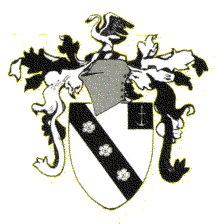Ca16 William Cary
Sir William Cary was the son of Sir Philip Cary (Ca17) and Christian Orchard Or17| Born: 1437 in , England
Died: May 06, 1471, beheaded after the Battle of Tewksbury.
|

Cary Coat of Arms |
| William Cary and Elizabeth Paulett had issue:
Ca15 Robert Cary William Cary and Alice Fulford had issue: Ca15-2 Thomas Cary of Chilton Foliot (d before 21.06.1536, Thomas Cary had two sons John Cary Ca15-2-1 and William Cary Ca15-2-2. William Cary married Mary Boleyne, sister of the famous Anne Boleyne, who bore Henry VIII's child. As compensation for taking Mary with the child he became Lord Hunsdon and a monument was erected for him in Westminster Abbey and the barony passed to Henry and Mary's child. The line seems to have fallen into abbeyance and could be claimed by some other descendant of William (Ca15-2-2).Ca15-3 William Cary |
Sir William Cary was an eminent Lancastrian, who upon the issue of
the Battle of Tewkesbury, 10th Edward IV (1471) fled to a church for sanctuary,
but was brought forth under promise of pardon but beheaded, which
would have been a perfidious breach of promise. Another
report is that the Yorkists led by Edward himself forced their way
into the Abbey and a bloodbath ensued. In the latter case a perfidious
promise of pardon may have been given by Edward after some of his men had
fallen while entering the Abbey gate just to get the Lancastrians
disarmed and save further losses of his own men. Either way, Edward violated
the sanctity of the Abbey, for which he could have been excommunicated.
A serious offense then and now, and there was no military necessity to
get them out of the Abbey immediately or to execute them without trial.
"Von: KingRichardIII@yahoogroups.com [mailto:KingRichardIII@yahoogroups.com]
Im Auftrag von Middleham@aol.com
Bill
When I visited the abbey a few years ago, I was informed by the curator of a number of interesting tidbits. The door that has a number of what I would call sword scars were said to be of the Yorkists trying to get into the abbey after they claimed sanctuary. I have often heard that Towton was a blood revenge battle, but this to me was one of pure vengeance by Edward IV. Sanctuary was law if a man claimed it but it does not seem to be the case here. For Edward IV not to allow it, and forcefully take out the Lancastrians within the abbey who claimed sanctuary was rare. The entrance to the abbey where these marks are is not so narrow that men could not get through even two by two. I am not familiar with Edward's promise of a pardon though claiming sanctuary may have been what they thought was enough. Your comment of Edward giving a promised pardon and then violating it, tells me what chroniclers do not. There was something else at play here, and no doubt Edward was thinking of how close he came to losing his crown, his throne and his message was he was not going to allow any man to stand in his way. It is kind of a bittersweet thought that if Richard had survived, he would not have been so forgiving or forgetting. As to where Richard was, we know only too well what he has been accused of thanks to the Bard and the Tudor historians, but if people knew the law of the time, they would know Richard had no power to order execution of anyone. Joe Ann Ricca
|
http://www.stirnet.com/HTML/genie/british/cc4aq/cary01.htm
He was an ardent supporter of the House of Lancaster, and took an active
part in the struggle between the adherents of Henry VI and Edward IV in
the WARS OF ROSES.
At the Battle of Tewksbury on May 4, 1471, the Lancastrians were defeated,
and William Cary with others took refuge in the Abbey Church. According to the
customs of the times the church was a 'Sanctuary', so that they could not
be taken out of it. They were enticed out on the promise of pardon and
two days later were beheaded. His property was confiscated as usual in
such cases, but Henry VII restored it to his son Robert. We cannot ascertain
for what reason, but probably because King Henry was a scion of the House
of Lancaster in whose cause, his father lost his life and property.
William left two sons Robert and Thomas. From Robert sprang the families
of Clovelly, Torre Abbey, and Somersetshire. And from Thomas the three
lines of nobles, Baron Hunsdon, Earl of Monmouth, and Viscount Falkland
Line.
He lived during the reign of Henry VI and Edward IV.
A Sir Richard Carey fought for Henry VI at the Battle of Towton
on March 29, 1461.